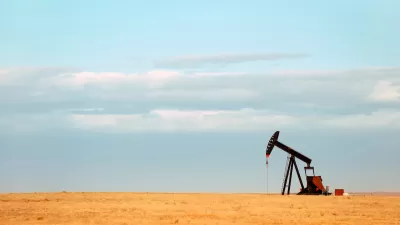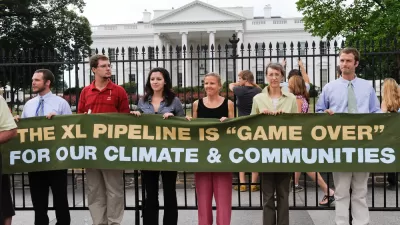The 'Willow' project would pump 600 million gallons of oil and emit 500 metric tons of carbon dioxide in the next 30 years.

"A federal judge’s decision on Wednesday to block a massive oil drilling project in Alaska’s National Petroleum Reserve handed a major victory to Indigenous and environmental advocates," reports Georgina Gustin.
"The so-called 'Willow' project envisioned by ConocoPhillips would extract nearly 600 million barrels of oil over the next three decades," explains Gustin of the project approved by the Trump administration and supported by the Biden administration. Environmentalists sued to stop the project shortly after it was approved last fall.
Judge Sharon L. Gleason of the United States District Court for Alaska agreed with opponents of the project, "writing that the administration’s approval of the project was arbitrary and capricious because it failed to account for the full scope of greenhouse gas emissions or for dangers to wildlife, including polar bears," reports Gustin.
Jeremey Lieb, a lawyer with Earthjustice, which represented several groups in the case, is cited in the article saying the project would add 500 million metric tons of carbon dioxide if allowed to proceed.
While the Biden administration has taken some steps to reverse some of the environmental decisions of the Trump administration affecting the state of Alaska, including a July decision to end the sale of large-scale, old-growth timber in the state's Tongass National Forest, approved by the Trump administration in October 2020.
The Biden administration supported the Willow project, however, "even as it attempts to advance an ambitious agenda that tackles climate change and shifts the country toward a fossil fuel-free future."
FULL STORY: A Federal Judge’s Rejection of a Huge Alaska Oil Drilling Project is the Latest Reversal of Trump Policy

Study: Maui’s Plan to Convert Vacation Rentals to Long-Term Housing Could Cause Nearly $1 Billion Economic Loss
The plan would reduce visitor accommodation by 25,% resulting in 1,900 jobs lost.

North Texas Transit Leaders Tout Benefits of TOD for Growing Region
At a summit focused on transit-oriented development, policymakers discussed how North Texas’ expanded light rail system can serve as a tool for economic growth.

Using Old Oil and Gas Wells for Green Energy Storage
Penn State researchers have found that repurposing abandoned oil and gas wells for geothermal-assisted compressed-air energy storage can boost efficiency, reduce environmental risks, and support clean energy and job transitions.

Private Donations Propel Early Restoration of Palisades Playground
Los Angeles has secured over $1.3 million in private funding to restore the Pacific Palisades playground months ahead of schedule, creating a modern, accessible space that supports community healing after recent wildfires.

From Blight to Benefit: Early Results From California’s Equitable Cleanup Program
The Equitable Community Revitalization Grant (ECRG) program is reshaping brownfield redevelopment by prioritizing projects in low-income and environmental justice communities, emphasizing equity, transparency, and community benefits.

Planting Relief: Tackling Las Vegas Heat One Tree at a Time
Nevada Plants, a Las Vegas-based nonprofit, is combating the city’s extreme urban heat by giving away trees to residents in underserved neighborhoods, promoting shade, sustainability, and community health.
Urban Design for Planners 1: Software Tools
This six-course series explores essential urban design concepts using open source software and equips planners with the tools they need to participate fully in the urban design process.
Planning for Universal Design
Learn the tools for implementing Universal Design in planning regulations.
Ascent Environmental
Borough of Carlisle
Institute for Housing and Urban Development Studies (IHS)
City of Grandview
Harvard GSD Executive Education
Toledo-Lucas County Plan Commissions
Salt Lake City
NYU Wagner Graduate School of Public Service





























